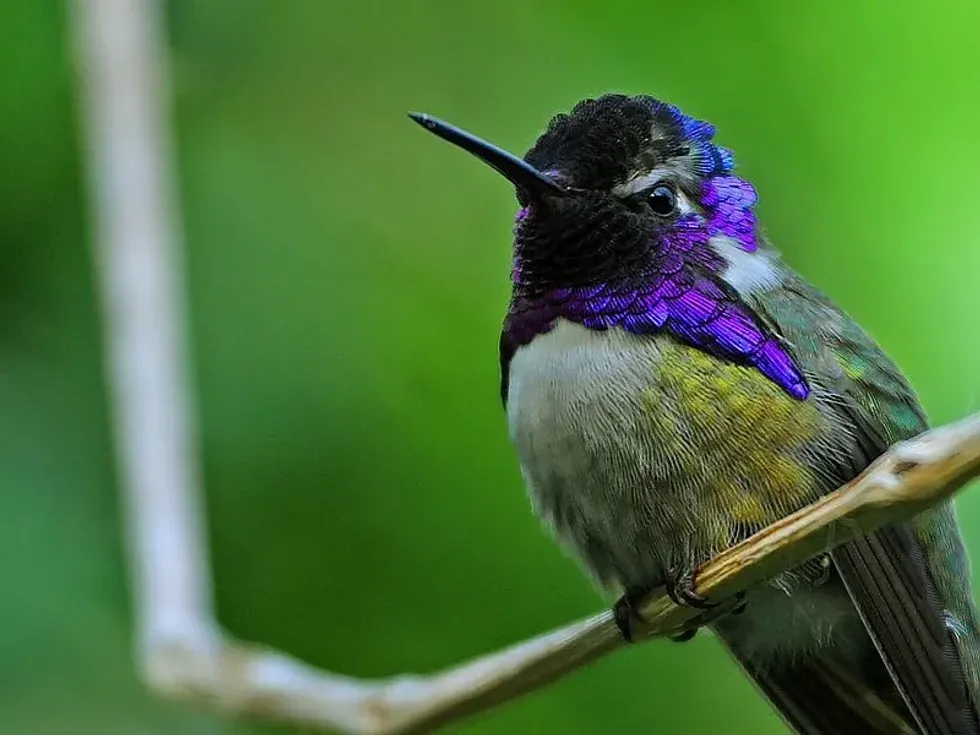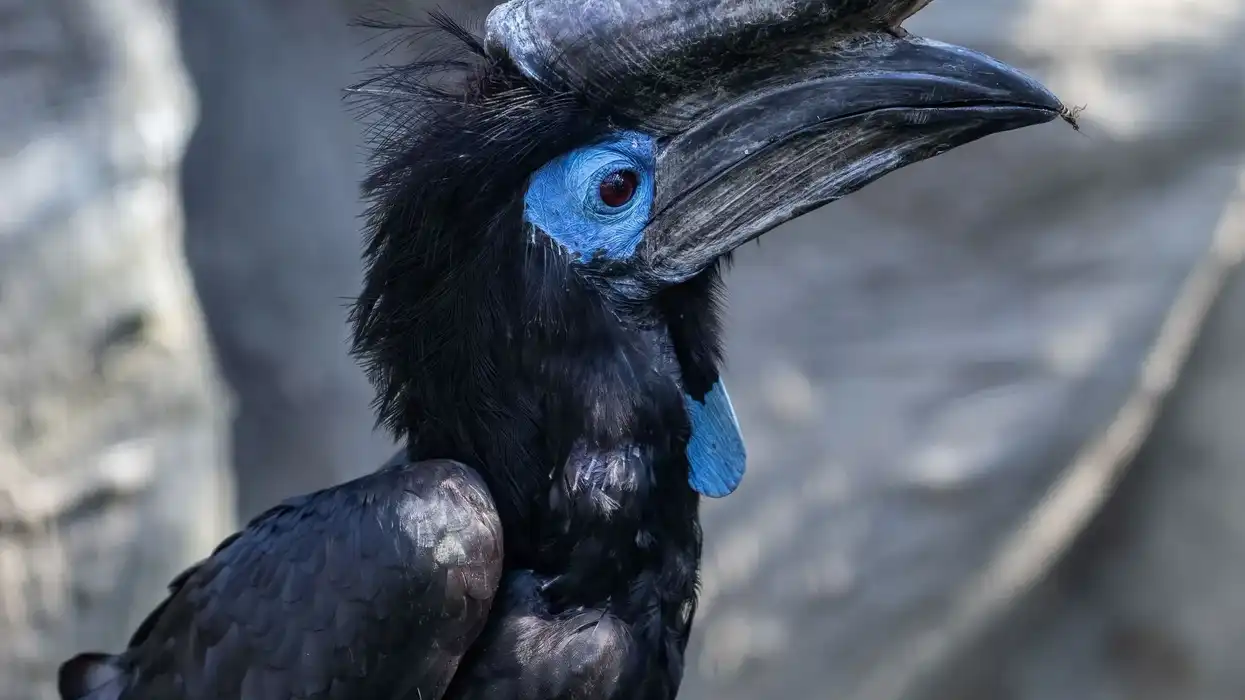There are so many occupants of the natural world that if an individual decides to look around and search each and every single one of them from the microscopic world to the macroscopic large animals he will be fascinated by each detail particularly in the Sonoran and Mojave deserts scrub.
In this fact file, we will discuss one such beautiful little North American bird, Costa's hummingbird (Calypte costae).
Costa's hummingbirds are native to the arid regions of the USA and Mexico.
Costa's hummingbirds breed in both places but spend most of their winter in Mexico.
Claude Marie Jules Bourcier is the expert on Costa's hummingbirds and was the first person to describe this bird in 1839. The scientific name of Costa's hummingbird is Calypte costae and was discovered by a famous French nobleman.
Here are great facts about Costa's hummingbird (Calypte costae), native to the Sonoran and Mojave deserts. For more relatable content, check out these rufous hummingbird facts and bee facts for kids.
Costa’s Hummingbird Interesting Facts
What type of animal is Costa’s hummingbird?
Male Costa’s hummingbird is a bird of the genus Calypte of the family Trochilidae. This bird is native to the southwest United States and northwest Mexico's desert habitats. It spends most of the winter in Mexico. This bird was first discussed and described by Claude Marie Jules Bourcier, a French nobleman and naturalist.
What class of animal does Costa’s hummingbird belong to?
Male Costa’s hummingbird belongs to class Aves, phylum Chordata, and kingdom Animalia. It further belongs to the family Trochilidae, the family of hummingbirds with about 360 species in total and the order Apodiformes. In the winter season, these birds only migrate till northern Mexico.
How many Costa’s hummingbirds are there in the world?
Male Costa's hummingbird breed in good numbers in their habitat of desert scrub with flowers. There is no proper count of their population but they are found in good numbers.
Where does Costa’s hummingbird live?
Male Costa’s hummingbirds search for an arid environment and preferably warm desert regions and garden areas with bushes. They are native to the southwestern United States and Baja Peninsula California of Mexico but mostly spend their winters in Mexico.
What is a Costa’s hummingbird's habitat?
A male Costa's hummingbird’s habitat is a range of shrubbery or forked branch of a tree in gardens and desert regions with some amount of vegetation with moderate climate. They build their nests there instead of tree cavities and nest boxes as they search for pleasant places to spend the night.
Who do Costa’s hummingbirds live with?
A hummingbird Costa’s just like any other hummingbirds search and prefers solitary life in a moderate climate. Hummingbird Costa's prefer dwelling alone and do not flock and migrate in groups. Hummingbird Costa's may only come together during the mating season.
How long does Costa’s hummingbird live?
A Costa’s hummingbird on average lives in a range of 5-10 years in the wild. In captivity or in a bird sanctuary under experts' care, they may live for longer than 10 years.
How do they reproduce?
During the courtship and mating display during the breeding season, they perform a series of swoops and arching dives. They do so to show off their violet plumage and attract their mates for breeding purposes.
Males dive near the branches where the females are around and produce sounds with their tails. Using their vocals they produce a variety of songs and sounds making breeding calls.
After courtship display, they will mate and the female lays eggs in the cup-shaped nest she constructs using a range of lichens, plant fibers, and spider webs.
They lay around two eggs and incubate them for a range of 18 days. The young ones born leave the nests after a range of 20 - 23 days after birth.
What is their conservation status?
The population range of Costa's Hummingbird is stable for now and they are listed as Least Concern species of birds under the IUCN Red List.
Costa’s Hummingbird Fun Facts
What does Costa’s hummingbird look like?
A Costa’s hummingbird is a small-sized bird. The male birds have green-black plumage, a black tail, white patches below their throat and tail, and flanks. Females are similar to males except they have a white belly above which they have grayish-green plumage.
How cute are they?
The young birds are really cute. Especially due to their small size and their plumage color and their overall stout and small appearance they appear even more attractive to the pedestrians during their flight and dive.
How do they communicate?
The Costa’s hummingbird has their own ways of high-pitched communication. Hummingbirds chitter and use their high-pitched vocal abilities to communicate with one another. Besides, they also use their vision to find their way.
How big is Costa’s hummingbird?
Even an adult Costa’s hummingbird is a really small, cute bird that is twice or smaller than a crow bird. Their wingspan measures somewhere between 4.3 in (11 cm) and the adult bird may grow around 3-3.5 in (7.6-8.9 cm) in length. Calliope hummingbirds and Anna's hummingbirds are a bit bigger than these birds.
How fast can Costa’s hummingbird fly?
Adult Costa’s hummingbirds fly with an average speed of 20-30 mph (32-48 kph). During their flight and especially during the courtship display these North American birds flap their wings very fast around 10-80 times in a second while hovering.
How much does Costa’s hummingbird weigh?
A cute little Costa’s hummingbird is a very lightweight bird. An average male bird weighs around 0.1 oz (3.1 g) in weight and the female Costa’s hummingbird may weigh around 0.11 oz (3.2 g) in weight. Swamp sparrows are five to six times bigger than them.
What are the male and female names of the species?
A male and female Costa’s hummingbird may be different in the slight coloration of the plumage but otherwise, they are almost similar in size and other features. Besides, males and females do not really have separate names and are referred to as male Costa’s hummingbird and female Costa’s hummingbird.
What would you call a baby Costa’s hummingbird?
A Costa’s hummingbird is generally referred to as a chick. But when they are out of eggs they are referred to as hatchlings and for the period they stay in the nest they are referred to as nestlings and when they are finally able to fledge they are referred to as fledglings.
What do they eat?
A Costa’s hummingbird mainly found in deserts feeds on flower nectar usually but they may also eat up the small insects that crawl around the flower. This is an indication of the omnivorous nature of these North American birds.
Are they dangerous?
These food-oriented beings found in deserts are not at all dangerous. Hummingbirds do not impose any harm to the humans but a male defending his territory of food may get aggressive with other male birds in his territory. Besides, the female bird may get aggressive while protecting her chicks from predators.
Would they make a good pet?
Laws are against petting these birds. A Costa’s hummingbird may not be able to survive in an enclosed area because they constantly feed on nectar from the flowers. This is one reason hummingbirds may be found in zoos or their natural habitats.
Did you know...
A Costa’s hummingbird shows a state called torpor which is a hibernation-like state. In this, they are able to slow down their metabolism especially during the winter nights. Their heart rate and respiration rate slows down and they are able to conserve energy.
Some of the special qualities of hummingbirds are the ability to fly forward, backward, or even upside down! Moreover, they are the only vertebrae that are able to hover during their flight.
Ecuador houses the largest amount of hummingbirds as well as hummingbird species in the world, with around 135 species present in the country.
Claude Marie Jules Bourcier, a French nobleman is attributed as the discoverer of this bird species.
What is the rarest hummingbird?
Esmeraldas woodstar is the smallest hummingbird and is also the rarest. These tiny birds measure barely 2.5 in (6.3 cm) long and are restricted to a small area in western Ecuador.
What is the most beautiful hummingbird?
Rufous-crested coquette is the most beautiful hummingbird found in the tropical regions of Pacific South America. These birds are really and are rarely sighted.
Here at Kidadl, we have carefully created lots of interesting family-friendly animal facts for everyone to discover! For more relatable content, check out these turkey facts and northern harrier facts pages.
You can even occupy yourself at home by coloring in one of our free printable costa’s hummingbird coloring pages.









